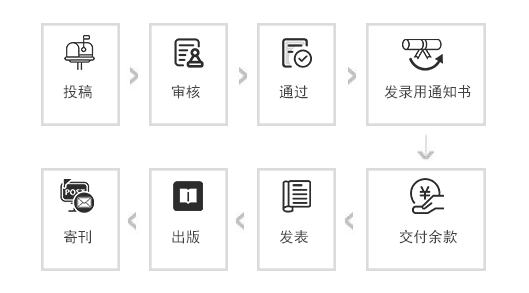FEMS MICROBIOLOGY LETTERS



- 中国知网数据库(CNKI)全文收录期刊
- 中国核心期刊(遴选)数据库收录期刊
- 中国万方数据库全文收录期刊
- 中国维普科技期刊数据库收录期刊
- 中国龙源数据库全文收录期刊
- 中国期刊网全文收录期刊



中国高校科技期刊研究会第9次会员代表大会在北京召开,中宣部出版局副局长张怀海、教育部科学技术与信息化司一级巡视员张国辉等领导出席会议并发表..
英文简介:FEMS Microbiology Letters gives priority to concise papers that merit rapid publication by virtue of their originality, general interest and contribution to new developments in microbiology. All aspects of microbiology, including virology, are covered. 2019 Impact Factor: 1.987, Journal Citation Reports (Source Clarivate, 2020)Ranking: 98/135 (Microbiology)The journal is divided into eight Sections:Physiology and Biochemistry (including genetics, molecular biology and ‘omic’ studies)Food Microbiology (from food production and biotechnology to spoilage and food borne pathogens)Biotechnology and Synthetic BiologyPathogens and Pathogenicity (including medical, veterinary, plant and insect pathogens – particularly those relating to food security – with the exception of viruses)Environmental Microbiology (including ecophysiology, ecogenomics and meta-omic studies)Virology (viruses infecting any organism, including Bacteria and Archaea)Taxonomy and Systematics (for publication of novel taxa, taxonomic reclassifications and reviews of a taxonomic nature)Professional Development (including education, training, CPD, research assessment frameworks, research and publication metrics, best-practice, careers and history of microbiology)If you are unsure which Section is most appropriate for your manuscript, for example in the case of transdisciplinary studies, we recommend that you contact the Editor-In-Chief by email prior to submission. Our scope includes any type of microorganism - all members of the Bacteria and the Archaea and microbial members of the Eukarya (yeasts, filamentous fungi, microbial algae, protozoa, oomycetes, myxomycetes, etc.) as well as all viruses.中文简介:(来自Google、百度翻译)FEMS Microbiology Letters优先考虑简明论文,这些论文因其独创性,普遍兴趣和对微生物学新发展的贡献而值得迅速发表。微生物学的所有方面,包括病毒学,都包括在内。2019影响因子: 1.987,期刊引文报告 (来源Clarivate,2020) 排名: 98/135 (微生物学) 期刊分为八个部分: 生理学和生物化学 (包括遗传学,分子生物学和 'omic' 研究) 食品微生物学 (从食品生产和生物技术到腐败和食源性病原体) 生物技术和合成生物学 病原体和致病性 (包括医学,兽医,植物和昆虫病原体-特别是那些与食品安全有关的病原体-病毒除外) 环境微生物学 (包括生态生理学,生态基因组学和元组学研究) 病毒学 (病毒感染任何生物,包括细菌和古细菌) 分类学和系统学 (用于发布新分类,分类重新分类和分类性质的评论) 专业发展 (包括教育,培训,CPD,研究评估框架,研究和出版指标,最佳实践,微生物学的职业和历史) 如果您不确定哪个部分最适合您的手稿,例如在跨学科研究的情况下,我们建议您在提交前通过电子邮件联系主编。我们的范围包括任何类型的微生物-细菌的所有成员和真核生物的古细菌和微生物成员 (酵母,丝状真菌,微生物藻类,原生动物,卵菌,粘菌等) 以及所有病毒。










英文简介:FEMS Microbiology Letters gives priority to concise papers that merit rapid publication by virtue of their originality, general interest and contribution to new developments in microbiology. All aspects of microbiology, including virology, are covered. 2019 Impact Factor: 1.987, Journal Citation Reports (Source Clarivate, 2020)Ranking: 98/135 (Microbiology)The journal is divided into eight Sections:Physiology and Biochemistry (including genetics, molecular biology and ‘omic’ studies)Food Microbiology (from food production and biotechnology to spoilage and food borne pathogens)Biotechnology and Synthetic BiologyPathogens and Pathogenicity (including medical, veterinary, plant and insect pathogens – particularly those relating to food security – with the exception of viruses)Environmental Microbiology (including ecophysiology, ecogenomics and meta-omic studies)Virology (viruses infecting any organism, including Bacteria and Archaea)Taxonomy and Systematics (for publication of novel taxa, taxonomic reclassifications and reviews of a taxonomic nature)Professional Development (including education, training, CPD, research assessment frameworks, research and publication metrics, best-practice, careers and history of microbiology)If you are unsure which Section is most appropriate for your manuscript, for example in the case of transdisciplinary studies, we recommend that you contact the Editor-In-Chief by email prior to submission. Our scope includes any type of microorganism - all members of the Bacteria and the Archaea and microbial members of the Eukarya (yeasts, filamentous fungi, microbial algae, protozoa, oomycetes, myxomycetes, etc.) as well as all viruses.中文简介:(来自Google、百度翻译)FEMS Microbiology Letters优先考虑简明论文,这些论文因其独创性,普遍兴趣和对微生物学新发展的贡献而值得迅速发表。微生物学的所有方面,包括病毒学,都包括在内。2019影响因子: 1.987,期刊引文报告 (来源Clarivate,2020) 排名: 98/135 (微生物学) 期刊分为八个部分: 生理学和生物化学 (包括遗传学,分子生物学和 'omic' 研究) 食品微生物学 (从食品生产和生物技术到腐败和食源性病原体) 生物技术和合成生物学 病原体和致病性 (包括医学,兽医,植物和昆虫病原体-特别是那些与食品安全有关的病原体-病毒除外) 环境微生物学 (包括生态生理学,生态基因组学和元组学研究) 病毒学 (病毒感染任何生物,包括细菌和古细菌) 分类学和系统学 (用于发布新分类,分类重新分类和分类性质的评论) 专业发展 (包括教育,培训,CPD,研究评估框架,研究和出版指标,最佳实践,微生物学的职业和历史) 如果您不确定哪个部分最适合您的手稿,例如在跨学科研究的情况下,我们建议您在提交前通过电子邮件联系主编。我们的范围包括任何类型的微生物-细菌的所有成员和真核生物的古细菌和微生物成员 (酵母,丝状真菌,微生物藻类,原生动物,卵菌,粘菌等) 以及所有病毒。
来稿要求:
论点新颖、论证严密、论据充足、文字精练。论文字数:5000字符-8000字符为宜,图表也要计算在内,不包括英文摘要关键词。
标 题:
文章标题要言简意赅,30字以内。作者署名:署真实姓名,注明作者单位、单位所在省市和邮政编码。摘 要:要用第三人称概括全文,300字以内。
关 键 词:
用3~8个关键词术语反映论文主题。专用符号:名词、术语、数字、计量单位、标点符号和数学符号等,必须符合国家标准;外文人名、地名和术语需译成中文。
图表格式:
文中插图与表格放在相应正文之后,分别按出现顺序用图1、图2或表1、表2统一编号。插图应为黑白色,其序号、标题及注释居中放在图的下方,表格的序号及标题置于表格上方,表注放在表格的下方(建议:由于篇幅限制,除核心期刊外尽量不用或少用图表)。
正文注释:
采用尾注形式,注释号①,②,③等标在相应正文右上角。
章节体例:
章节标题为:一级标题不编号,用黑体居中排,二级标题不编号,用楷体放在相应的文字段首与正文空一字格接排正文。 三级标题分别用1.2.3.顺序编号。文中接排标题用(1),(2)编号。
参考文献:
参考文献置于正文之后,近5年的不少于3条,用[1],[2]……顺序编号,如文章中有内容需要解释请用尾注形式。参考文献不全者不能进入审稿阶段。{参考文献格式如下:(1)图书:作者.书名(版本)[M].出版所在地: 出版社,出版年:(1)页码.
(2)期刊:作者.题目[J].期刊名,年,卷(期):页码.
(3)电子参考文献:作者.题目[OL].(文章的发表日期).[本文引用日期].作者简介:来稿者请附个人简介,内容包括姓名(出生年—),性别,籍贯,民族,学历,工作单位,职称,研究方向,通讯地址,联系电话及电子信箱。
一般情况下,您将在3个工作日内收到审稿结果。如文章有很强的时效性,请说明需要最晚刊发时间。
| 论文编号 | 作者姓名 | 论文题目 | 录用情况 |
|---|---|---|---|
| TG251-13579 | 韩丽炘 孟涛 温娟娟 刘晓琴 | 基于互联网的CBL+TBL教学法在病理学实验教学中的应用 | 已录用 |
| TG251-13681 | 邹隆强 杨清余 钟鸿路 李正南 陈 | 医学运动康复联合消肿止痛方治疗急性踝关节扭伤临床研究 | 已录用 |
| TG251-13794 | 林雨慧 陈霄雯 郑颖彦 朱永凯 贾 | 基于SWOT模型的儿童专科医院临床研究发展策略分析 | 已录用 |
| TG251-13762 | 郑鸿雁 | 重复经颅磁刺激治疗肝脾不调型功能性肛门直肠痛的临床研究 | 已录用 |
| TG251-13891 | 袁召1 赵会谢2 赵海深3 | 真武汤治疗阳虚水泛型慢性心力衰竭患者的临床研究 | 已录用 |
| TG251-13536 | 王杰1 张蕾蕾2 | 血脂和载脂蛋白水平与分化型甲状腺癌及其病理学特征的相关性探究 | 已录用 |
| GD24-5203 | 单一青 高鹏慧 姚瑶 | 思维导图护理对宫颈癌患者行腹腔镜术后康复的影响 | 已录用 |
| GD24-5217 | 林秀娟 梁静文 刘美仙 陈惠贤 | 加速康复外科管理模式在胸腔镜肺段切除术患者围手术期护理中的应用效果 | 已录用 |
| GD24-5213 | 杨素雯 何洁芳 陈妙霞 廖景升 | 健康行为改变整合理论对于宫颈癌晚期放疗患者依从性及自我效能的影响 | 已录用 |
| GD24-5199 | 杨月惠 王凤婷 | 个体护理计划在心脏瓣膜置换手术围手术期患者中的应用 | 已录用 |
邮箱:cnkibianjibu@163.com
QQ:
扫码联系: